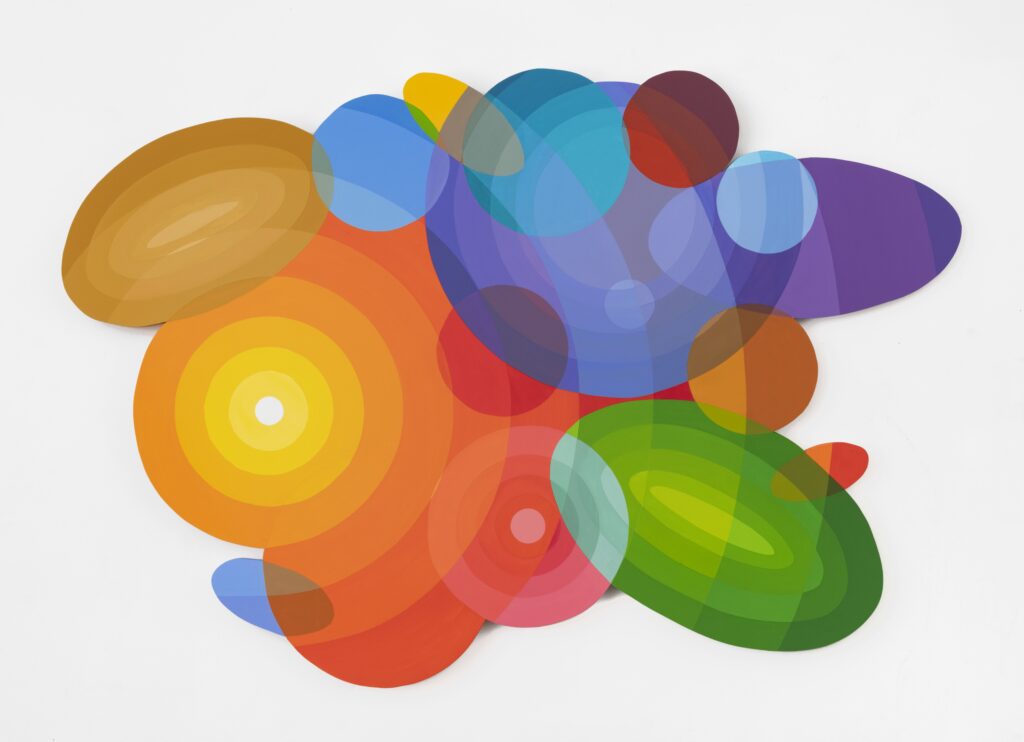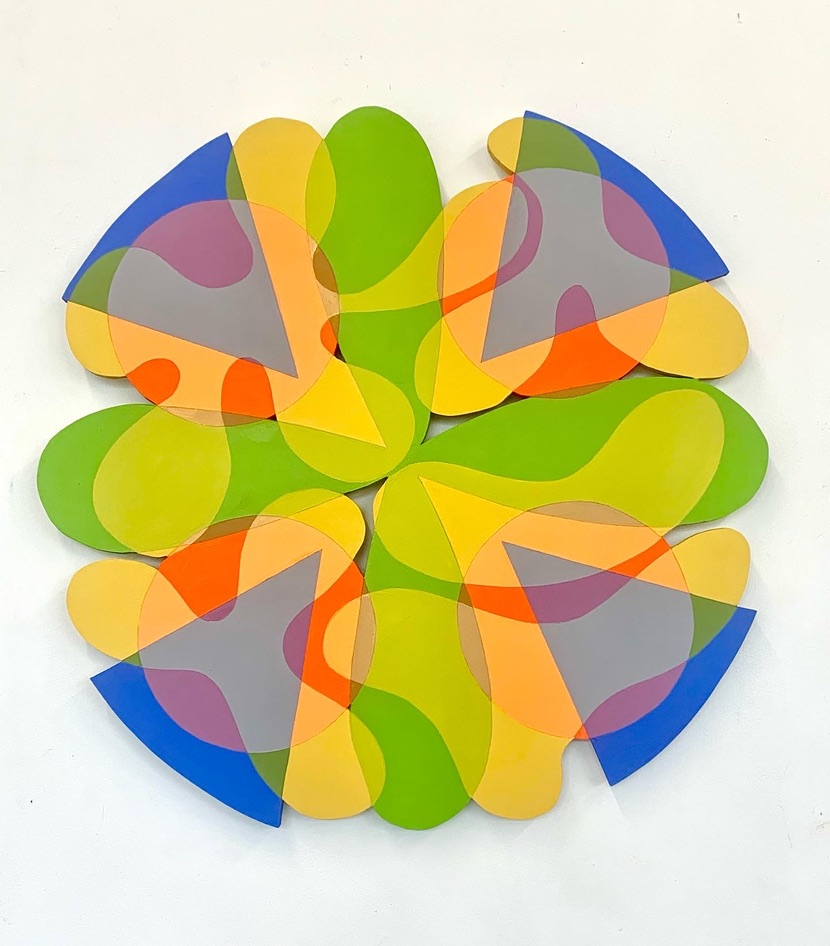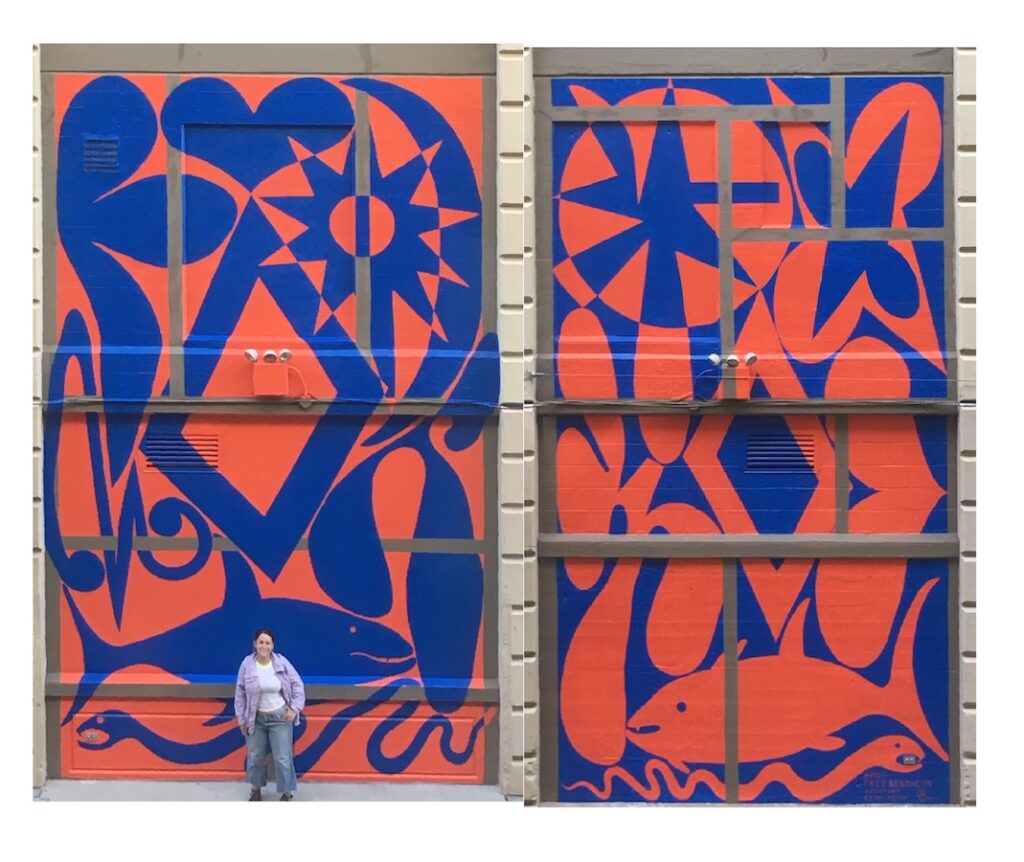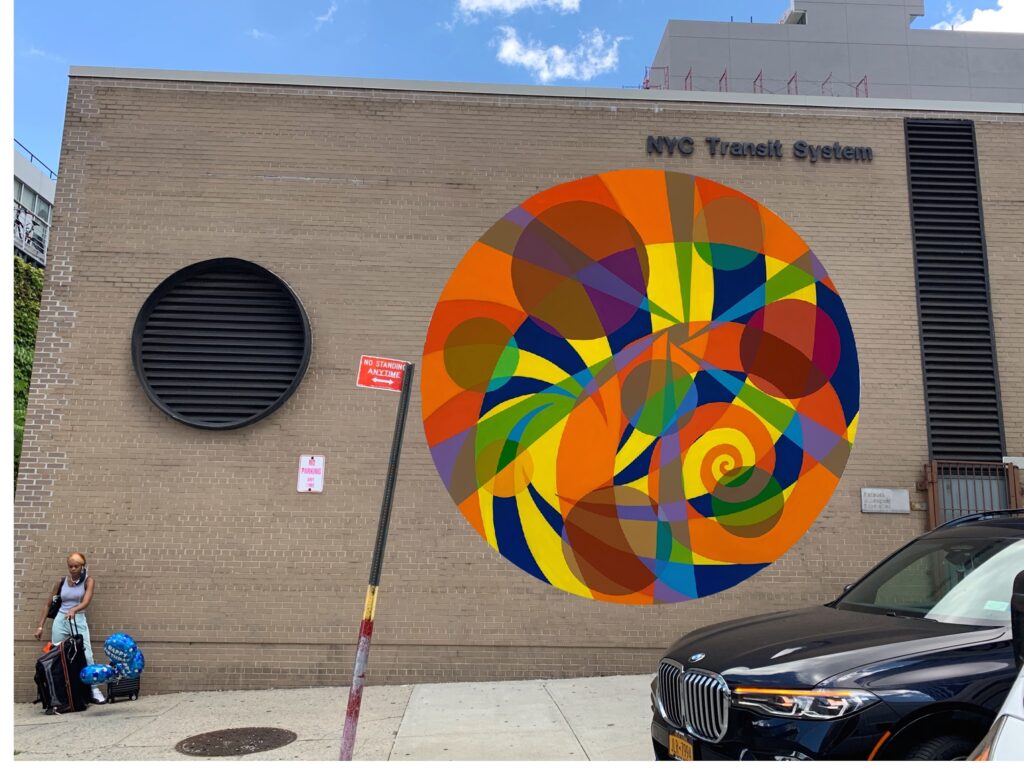Artist Describes Shaped Paintings and Public Art Designed by Intuition
By Meagan J. Meehan | news@queensledger.com

Vividly colored shapes and overlaid hues are combined to create eye-catching and vibrant sculptural paintings which first take root in the mind of artist Fred Bendheim who subsequently brings these abstract visions to life in his Prospect Heights studio. Originally from Phoenix, Arizona, Fred apprenticed with artist Philip Curtis—a founding artist of The Phoenix Art Museum—when he was a teenager. Fred then attended The University of California, Davis, where he studied art with William T. Wiley and Wayne Thiebaud before earning a B.A. in Art from Pomona College. He started his career as a professional artist in San Francisco, California, and exhibited his unique pieces at SFMoMA.
In 1984, Fred moved to Brooklyn and has stayed in New York ever since. His work has appeared at The Museum of Arts and Design in NYC, The Montclair Art Museum, The Scottsdale Museum of Contemporary Art, The National Museum of Costa Rica, The Neiman-Marcus Collection, Bradley International Airport, The Brooklyn Public Library, Sotheby’s Realty and many more. Fred is also a muralist who has completed four public murals—including two large painted murals in Brooklyn. His artworks can be found in South Korea, Costa Rica, Italy and Germany and he is presently represented by several New York galleries including Julie Keyes Fine Art, 490 Atlantic Gallery, and 440 Gallery.
As with many artists of the modern age, Fred also holds a part-time job…albeit one that is firmly rooted in the creative arena: he is a teaching artist at The Art Students League of New York and he has also instructed students at The College of Mt. Saint Vincent, Young Audiences of New York, The Brooklyn Museum, and Learning Leaders.
Fred feels that his artistic inspirations come from a strong sense of intuition, composition and design; form, line, and color are his means of communicating specific feelings and his art spans boundaries between painting, sculpture, figuration and abstraction. Currently, Fred is keeping himself busy working on a brand-new series of abstract-shaped paintings for shows in New York galleries including Brooklyn’s 440 Gallery and 490 Atlantic Gallery.
Fred recently discussed his art and career via an exclusive interview.
Meagan Meehan (MM): How did you initially get interested in art and how did you develop your original style?
Fred Bendheim (FB): As a child I was lucky to grow up in an interesting house full of art. My parents had art from their families from Germany and New York, and they collected some contemporary artists, and Native American artists where we lived in Arizona. They also made some art, ceramics and wood carvings. I remember my father once made napkin holders from the skeletons of cacti. The desert landscape was always present as well, which had a visual influence on me. My style developed slowly over fifty years of making art and has gone through many permutations.

MM: You are known for your sculptural wall hangings, but you have also created fountains! What is that process like and where can the general public see these fountains?
FB: I’ve always been fascinated by water and all of the forms it takes, and I have made about five fountains/sculptures over the years. Two are made from stone and concrete and are permanently on display in Arizona (one in a Frank Lloyd Wright building in Scottsdale). The others were temporary and more whimsical—one was made from suspending celery stalks which I used as channels for the water. For another fountain I used plastic forms and translucent hoses. The sound of the water is important as well. I’ve also painted themes of water over the years. Several years ago, I had a mini-retrospective on the theme of water. It’s a theme I return to. Water is always water, but always different, like a river is never the same water from moment to moment. Its sameness flows into its mutability.
MM: You also make public art, such as murals. So, where can Brooklynites see your murals and how did these opportunities come to you?
FB: I’ve made several murals and public art pieces in New York. Some were temporary installations, like “Song For Harlem” (2013) which was commissioned by Chashama for a large storefront in Harlem. I covered the windows with cut yellow paper, and then installed blue lights inside the building, so the appearance changed from day to night. I’ve also collaborated with young student artists and had their art printed on billboards on Fourth Avenue in Brooklyn, and I made a mural from food packaging for a grocery store with students. The murals I was very proud of were two large site-specific murals I made for Industry City in 2019 called “Creationism” and “Evolution.” They were very successful works and were well-received by the public. They were mostly abstract but had some recognizable features like snakes and a figure of the Virgin of Guadalupe. Unfortunately, the murals were destroyed. People ask me why, and I can’t explain it, except to say these people had different notions about art than I do. I think they were interested in using art as PR via social media posts. So, the more posts of different art, the more PR (and profits). Since then, and because many people complained about their destruction, I believe they have changed their policy with regards to murals they commission, but it came too late for my murals. So, I learned a painful lesson about making public art. I don’t think people realize the extent of work and feelings that goes into artmaking. It can feel similar to making (and losing) a child.
MM: You grew up in Arizona and spent a lot of your early adulthood in California but now you live and work in Brooklyn. How does the art scene in Brooklyn compare to the one out West?
FB: I’ve been in Brooklyn since 1984 and I’ve seen a lot of changes here. I did spend my early years out west but can’t really say what the art scene is like there now. Generally speaking, there’s more art and less nature here in NYC, but I continue to be inspired by nature, even if it’s an internalized nature. Brooklyn probably has more artists than anywhere in the world, and more galleries are popping up here. I live near the Brooklyn Museum which is a great resource. I like art that is universal in its appeal. The subject matter can be anything: Brooklyn, political or abstract feeling-based art, but the form and structure has to be universal, so no matter when and where it’s seen it’s still relevant. I’ve recently moved my studio to my home in Prospect Heights. I have a lot of plants in two gardens, so I’m sure that will affect my art.
MM: Do you feel that the vibrancy of Brooklyn inspires you at all and what’s your favorite thing about being a Brooklyn-based artist?

FB: I like being able to see the sky in Brooklyn, as opposed to being in the more closed spaces of Manhattan. I like having some outdoor spaces to play in here. Space is very important both physical and mental space.
MM: How did you find gallery and museum representation for your work?
FB: New York has a lot of opportunities for artists. Some of it is networking and there’s some luck involved too.
MM: You have art in Neiman Marcus stores—that’s actually how I initially found out about your work! How did that opportunity come to you?
FB: I have a painting called “Thundercloud” in the Neiman-Marcus collection on Long Island. That happened through an art consultant from the Bay Area that knew of my work.
MM: You’re a member of the 440 Gallery in Park Slope which is an artist collective. How has that helped you gain exposure for your work?
FB: 440 Gallery has been in Park Slope for almost twenty years. We have 15 artist members and an enthusiastic and dedicated following. I also show my work at 490 Atlantic Gallery in downtown Brooklyn. I had an exhibition there called Alltogethernow which consisted of twelve of my recent abstract shaped paintings.
MM: You work as an art teacher, so what is some of the advice that you give to budding artists?
FB: In technical terms I tell them that if the art isn’t working it’s a 99% chance it’s a compositional problem. Even if the color looks wrong, it’s composition. In terms of being an artist and having some ambitions for your art-good luck! Just keep going…
MM: Does working with students influence your own creativity at all?
FB: I like the energy of working with students, especially if they’re serious about their art. Sometimes the beginner’s mind is best for making art. Picasso said he spent years learning to paint like a master and spent his whole life learning to paint like a child.
MM: You have written articles about art for a British medical journal called The Lancet. How does art figure into a medical journal and what topics have your articles focused on?
FB: I wrote for The Lancet in a section they had on culture. I wrote mostly reviews of art shows, and I wrote a series of articles on science and art. Through those articles, I was invited to attend a forum on “Art and Astronomical Phenomena” in Venice, where I showed some of my work dealing with astronomical themes.
MM: Be honest, out of all of your creations, do you have any particular favorite piece?
FB: My murals at Industry City were art that I was very proud of. The twelve paintings I had on display at 490 Atlantic are some of my favorites. I also have some earlier work that I’m pleased with in hotels, hospitals and in storage. I am proud of my body of work consisting of hundreds of paintings, drawings and collage work.
MM: You have had an incredible international career, but what would you say has been the highlight of your artistic career so far?
FB: I’ve enjoyed doing art residencies in Costa Rica. I’ve been going there since 2001 and it’s been a nice place to work and do some things I wouldn’t normally do here in Brooklyn, like use the tropical foliage and leaf-cutter ants to make art. I am going to Mexico soon to see the art there.
MM: Can you tell us a little more about the new art that you’re actively making?
FB: I’ve recently been working in aluminum. Sometimes I paint on it, and sometimes I use it raw. I use conventional tools for drawing as well as an iPad to design them. I have them laser cut (instead of doing the cutting myself like I usually do). Making them in aluminum allows the forms to be more varied, thinner for instance, and they can be shown outside.
MM: What are your ultimate goals for the future and is there anything else that you would like to mention?
FB: I’d like more people to see my work, so I’m looking around for new places to show it, including more public spaces. I’d also like to teach more and perhaps travel with my work. The artists at the 440 Gallery and I will be traveling to Berlin this July for a group show at a gallery there. We are doing an exchange show with EP Contemporary Gallery in Berlin, so the artists from Berlin will be showing at 440 Gallery in June and then we will go to Berlin in July.
To learn more about Fred, visit his official website: fredbendheim.com. You can also follow him on Instagram @artist_fredbendheim.



